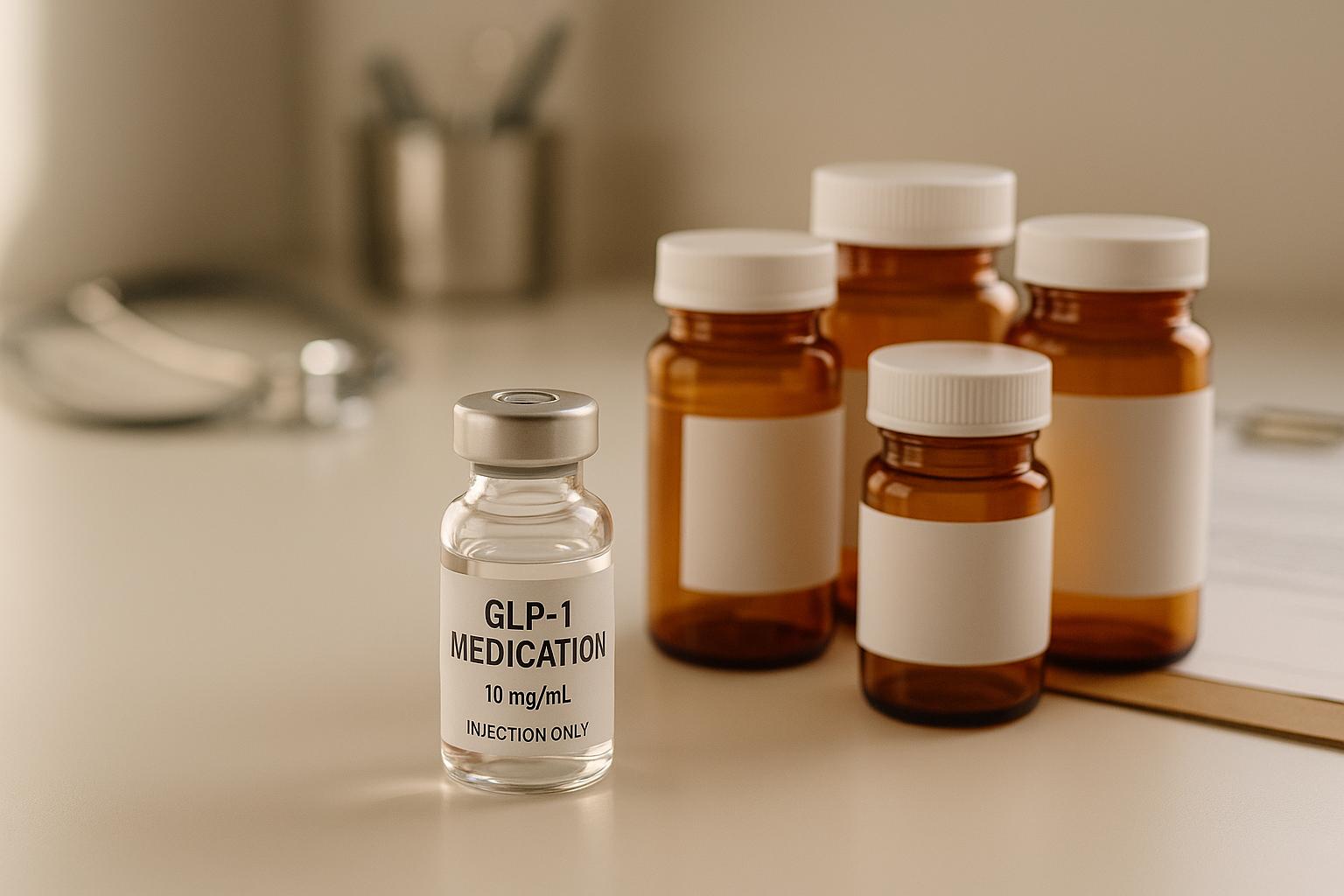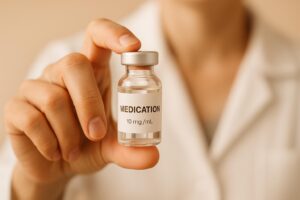6 Common Drug Interactions with GLP-1 Medications

GLP-1 receptor agonists are effective for managing Type 2 diabetes and obesity, but they can interact with other medications. These interactions often stem from delayed gastric emptying, which alters how drugs are absorbed. Here’s a quick look at six common interactions:
- Sulfonylureas: Increased risk of hypoglycemia; dose adjustments and frequent blood sugar monitoring are needed.
- Insulin: Higher chance of low blood sugar; insulin doses may need to be reduced.
- Oral Contraceptives: Slower absorption can reduce effectiveness; alternative contraceptive methods may be safer.
- Digoxin: Absorption changes can lead to reduced effectiveness or toxicity; regular monitoring is critical.
- Warfarin: INR levels may fluctuate, increasing bleeding risks; close INR monitoring is essential.
- Narrow Therapeutic Window Drugs (e.g., lithium, phenytoin): Absorption delays can cause treatment failure or toxicity; timing and blood level checks are key.
Each interaction requires careful management, such as adjusting doses, monitoring symptoms, and timing medications appropriately. Always consult your healthcare provider to ensure safe and effective use of GLP-1 therapies.
Drug interactions you should be aware of on GLP-1 medications
1. Sulfonylureas
Sulfonylureas, commonly prescribed for managing Type 2 diabetes, can interact with GLP-1 receptor agonists, requiring careful monitoring. Medications in this category include glyburide, glipizide, and glimepiride.
Type of Interaction
The interaction between GLP-1 receptor agonists and sulfonylureas stems from their combined effects on blood sugar. GLP-1 receptor agonists stimulate insulin release only when blood sugar is elevated and suppress glucagon secretion. In contrast, sulfonylureas continuously promote insulin release, regardless of glucose levels. Together, these drugs amplify blood sugar reduction, which raises the risk of hypoglycemia.
Clinical Risks
The most significant concern with combining these medications is the heightened risk of severe hypoglycemia. While GLP-1 receptor agonists naturally reduce their activity as blood sugar normalizes, sulfonylureas persist in driving insulin secretion even when glucose levels are already low. This can lead to dangerously low blood sugar levels.
Symptoms to Watch For
Be on the lookout for early signs of hypoglycemia, including shakiness, sweating, rapid heartbeat, dizziness, and weakness. Severe symptoms might include blurred vision, slurred speech, poor coordination, or even loss of consciousness. Regular blood sugar monitoring is crucial, especially if early warning signs are subtle or absent.
Management Tips
To reduce the risk of hypoglycemia, healthcare providers often recommend lowering the sulfonylurea dose when starting GLP-1 therapy. During the initial weeks of combined treatment, frequent glucose checks are essential. Always have fast-acting carbohydrates, like glucose tablets or juice, on hand to quickly address low blood sugar episodes as advised by your doctor.
2. Insulin
Combining insulin therapy with GLP-1 receptor agonists changes how insulin works in the body, particularly its timing. This combination is often used for people with Type 2 diabetes who need more than one medication to keep their blood sugar in check. However, using insulin alongside GLP-1 therapies requires careful adjustments to prevent low blood sugar (hypoglycemia).
Type of Interaction
The interaction between insulin and GLP-1 medications is mostly pharmacodynamic. GLP-1 agonists increase insulin release when blood sugar levels are high and reduce glucagon levels. They also slow down how quickly food leaves the stomach, which can create a mismatch between short-acting insulin’s peak activity and when the body absorbs carbohydrates from meals.
Clinical Risks
The biggest concern when using insulin with GLP-1 receptor agonists is the higher chance of hypoglycemia. Because GLP-1 therapies slow gastric emptying, insulin might start working before the carbohydrates from food are absorbed. While severe hypoglycemic episodes are rare in clinical studies, mild cases can still occur, making close monitoring essential.
Symptoms to Monitor
Be alert for early signs of hypoglycemia, such as shakiness, sweating, or feeling hungry. More severe symptoms might include blurred vision, confusion, or slurred speech.
Management Strategies
To reduce risks, healthcare providers often lower insulin doses when starting GLP-1 therapy. Adjusting insulin timing can also help align it with the slower digestion of carbohydrates. For those using short-acting insulin, switching to rapid-acting insulin analogs may better match the delayed carbohydrate absorption. Regular blood sugar checks are crucial, and keeping fast-acting carbohydrates on hand is an important safety precaution. Close monitoring ensures any issues are caught early.
3. Oral Contraceptives
GLP-1 receptor agonists can delay how quickly the stomach empties, which might interfere with the absorption of oral contraceptives. This delay could reduce the effectiveness of these contraceptives, similar to how GLP-1 medications interact with other drugs.
Type of Interaction and Clinical Considerations
The interaction here mostly affects absorption. Slower absorption can lead to lower hormone levels, which might make birth control pills less reliable and increase the chance of an unintended pregnancy. On top of that, common gastrointestinal side effects like nausea or vomiting – especially when starting GLP-1 therapy – can further disrupt how well the contraceptive hormones are absorbed. These factors highlight the importance of careful monitoring when combining oral contraceptives with GLP-1 therapy.
What to Watch For
Pay attention to any changes like irregular periods, breakthrough bleeding, or gastrointestinal symptoms that occur around the time you take your pill.
Management Tips
If you notice changes in your cycle or other concerns, reach out to your healthcare provider. They might suggest alternative contraceptive options that don’t depend on the digestive system, such as intrauterine devices, implants, or patches, to ensure consistent protection.
4. Digoxin
Let’s take a closer look at how digoxin, a medication commonly used for atrial fibrillation and heart failure, interacts with GLP-1 medications. Because digoxin has a narrow therapeutic window – meaning the margin between a helpful dose and a harmful one is slim – any changes in how the body absorbs it can have serious consequences.
Type of Interaction
The issue here is all about absorption. GLP-1 receptor agonists slow down gastric emptying, which can reduce how much digoxin is absorbed into the bloodstream.
Clinical Risks
When digoxin absorption decreases, its effectiveness can drop, potentially worsening heart failure symptoms or making atrial fibrillation harder to control. On the flip side, if gastric emptying returns to normal suddenly, absorption might spike, increasing the risk of toxicity. This makes careful management of these medications crucial.
Symptoms to Monitor
It’s important to keep an eye out for symptoms that could signal either low or high digoxin levels.
If digoxin levels are too low, you might notice signs like:
- Worsening shortness of breath
- Unusual fatigue
- Irregular or rapid heartbeat
- New swelling in your ankles or legs
If digoxin levels are too high (toxicity), symptoms could include:
- Nausea or vomiting
- Loss of appetite
- Confusion
- Visual changes, like halos around lights
- Abnormal heart rhythms
Management Strategies
To stay safe, your healthcare provider will likely monitor your digoxin levels more closely when starting or stopping GLP-1 therapy. They might also suggest taking digoxin at a different time than your GLP-1 medication to improve absorption.
Keeping a symptom diary can be a helpful tool. Jot down any changes in energy, breathing, or heart rhythm, as these details can provide valuable insights for your care team. This approach mirrors strategies used for managing other drug interactions and helps ensure you stay on track.
sbb-itb-e2779c3
5. Warfarin
Warfarin, a commonly prescribed blood thinner, requires careful monitoring when combined with GLP-1 medications. Its narrow therapeutic range means even small changes can have significant effects.
Type of Interaction
When used alongside GLP-1 medications like semaglutide, tirzepatide, or exenatide, warfarin’s peak levels may be delayed due to slower gastric emptying. While this doesn’t change how much of the drug is absorbed overall, it can raise your International Normalized Ratio (INR) – a key measure of blood clotting time.
Clinical Risks
The biggest concern here is an increased risk of bleeding. Higher INR levels mean your blood is thinner, which makes it harder to form clots. For most people, the effects of this interaction are manageable. However, the risks grow if you have kidney issues or need frequent dose adjustments. Even minor changes in warfarin levels can lead to serious clotting or bleeding problems, underscoring the importance of regular monitoring when taking GLP-1 medications.
Symptoms to Monitor
Keeping an eye out for signs of bleeding is crucial when you’re taking warfarin with GLP-1 medications. Symptoms can range from obvious to subtle and include:
External bleeding signs:
- Unexplained bruising
- Frequent or hard-to-stop nosebleeds
- Bleeding gums during brushing
- Cuts that take longer than usual to stop bleeding
Internal bleeding warning signs:
- Dark, tarry stools or bright red blood in stool
- Vomiting blood or material resembling coffee grounds
- Severe headaches or dizziness
- Extreme fatigue or weakness
- Heavy menstrual bleeding (for women)
Management Strategies
To reduce risks, your healthcare provider will likely check your prothrombin time and INR more frequently when you start or adjust GLP-1 medications. This is especially important in the first few weeks as your body adapts to the combination.
Although dose changes for warfarin are not typically needed when starting GLP-1 therapy, adjustments may be made based on your INR levels. Keep track of any unusual bleeding and share it with your doctor to help fine-tune your treatment plan.
If you’re participating in TrimRX‘s personalized weight loss program and taking GLP-1 medications, be sure to mention your warfarin use during consultations. This allows the care team to work with your prescribing physician to keep your clotting levels in check throughout your weight loss journey.
6. Other Oral Medications with a Small Therapeutic Window
Certain medications, like lithium, phenytoin, cyclosporine, and theophylline, have a narrow therapeutic window. This means their dosing must be precise – small changes in absorption can lead to either treatment failure or toxic side effects.
Type of Interaction
GLP-1 medications can slow down how quickly the stomach empties, which affects how these drugs are absorbed. This delay can shift the timing of their peak concentration, potentially pushing their levels outside the safe and effective range.
The medications most impacted include:
- Lithium: Commonly prescribed for bipolar disorder.
- Phenytoin: Used to control seizures.
- Cyclosporine: An immunosuppressant for transplant patients.
- Theophylline: Treats asthma and COPD.
Because these drugs have such a small margin between therapeutic and toxic doses, even slight changes in absorption can heighten risks.
Clinical Risks
When absorption becomes unpredictable, drug levels can fluctuate. This can result in:
- Subtherapeutic levels: The medication isn’t working as intended, leading to treatment failure. For example, lithium may no longer stabilize mood, or phenytoin levels might drop low enough to trigger seizures.
- Toxic accumulation: Over time, delayed absorption could cause levels to build up dangerously, leading to side effects like lithium toxicity.
The degree of impact varies from patient to patient. Some may notice little to no change, while others experience significant shifts, making individualized monitoring essential for safety.
Symptoms to Monitor
The symptoms of fluctuating drug levels depend on the medication, but here are some general warning signs:
Low drug levels:
- Return of symptoms the medication was prescribed to treat.
- Seizures (for anti-seizure medications like phenytoin).
- Mood instability or changes (for psychiatric medications like lithium).
- Worsening of chronic conditions, such as asthma or COPD.
High drug levels:
- Nausea, vomiting, or digestive issues beyond usual GLP-1 side effects.
- Unusual fatigue, confusion, or drowsiness.
- Tremors, muscle weakness, or coordination problems.
- Irregular heart rhythms or changes in blood pressure.
For specific drugs, watch for unique signs. For instance, lithium toxicity might present as excessive thirst, frequent urination, or hand tremors. With theophylline, be alert for a rapid heartbeat, restlessness, or difficulty sleeping.
Management Strategies
Managing these interactions requires a proactive approach:
- Frequent monitoring: Blood levels may need to be checked every 4–6 weeks when starting GLP-1 therapy to ensure the medication remains in the therapeutic range.
- Adjust timing: Take narrow-window medications 1–2 hours before your GLP-1 injection to minimize absorption delays.
- Dose adjustments: Based on blood test results, your doctor may tweak your medication dose temporarily to account for changes in how your body processes the drug.
To ensure the best outcomes, provide a complete list of all your medications during your TrimRX consultation. This allows your healthcare provider to optimize dosing and timing for your specific needs.
Drug Interaction Summary Table
Here’s a quick reference for common GLP-1 medication interactions, aimed at helping healthcare providers and patients navigate potential challenges. The table outlines interaction types, associated risks, symptoms to watch for, and practical management tips. Since individual reactions can differ, it’s important to collaborate with your healthcare provider and utilize TrimRX’s personalized consultation process for tailored adjustments.
| Drug Class | Interaction Type | Primary Risks | Key Symptoms to Monitor | Management Strategy |
|---|---|---|---|---|
| Sulfonylureas (e.g., Glyburide, Glipizide, Glimepiride) | Enhanced glucose-lowering effect | Higher risk of hypoglycemia | Shakiness, sweating, confusion, rapid heartbeat, dizziness | Adjust sulfonylurea dose as needed and increase blood glucose monitoring frequency under your provider’s guidance |
| Insulin (Rapid-acting, Long-acting) | Additive hypoglycemic effect | Risk of severe low blood sugar levels | Extreme hunger, blurred vision, irritability, weakness, sweating | Review and adjust insulin doses with frequent glucose checks to maintain safety |
| Oral Contraceptives | Potential for altered absorption | Reduced contraceptive effectiveness | Irregular menstrual cycles, spotting, or signs of decreased efficacy | Discuss timing with your provider. Taking contraceptives separately from GLP-1 injections and using backup contraception may be advised |
| Digoxin | Changes in drug absorption | Risk of toxicity or reduced effectiveness | Nausea, visual disturbances, irregular heartbeat, fatigue | Regularly monitor digoxin levels and adjust dose timing to maintain therapeutic stability |
| Warfarin | Modified absorption patterns | Fluctuating INR levels, increasing bleeding or clotting risks | Unusual bruising, prolonged bleeding, blood in urine or stool | Monitor INR levels closely and adjust warfarin dosage as needed during GLP-1 therapy |
| Other Oral Medications with a Narrow Therapeutic Index (e.g., Lithium, Phenytoin, Cyclosporine, Theophylline) | Altered absorption due to slowed gastric emptying | Risk of reduced effectiveness or toxic buildup | Recurrence of symptoms, tremors, confusion, coordination issues | Time doses appropriately relative to GLP-1 injections and schedule regular blood level checks as recommended |
Key Tips for Managing Interactions
- Timing Is Critical: For medications affected by absorption, take them at a time separate from your GLP-1 injection. Your healthcare provider can help determine the best schedule.
- Individual Differences: Everyone responds differently. Some may need only small adjustments, while others might require more significant changes.
- Enhanced Monitoring: Regular blood tests and symptom tracking during the first few weeks of GLP-1 treatment can help catch and address issues early.
- Be Prepared: Keep supplies like glucose tablets on hand and maintain an up-to-date list of your medications, especially during periods of dose changes.
Conclusion
Understanding how GLP-1 medications interact with other drugs is key to ensuring safe and effective treatment. The six interactions we’ve discussed – sulfonylureas, insulin, oral contraceptives, digoxin, warfarin, and medications with a narrow therapeutic index – each come with specific challenges that demand thoughtful management and close monitoring.
The foundation of successful GLP-1 therapy is open communication with your healthcare provider. Be sure to share a full list of your medications before starting GLP-1 therapy. Early and ongoing monitoring of blood glucose, INR levels, and other relevant markers can help identify and address potential issues early on.
Timing also plays an important role. Adjusting when you take certain oral medications in relation to your GLP-1 injection can improve absorption and maintain their effectiveness, all while supporting your weight loss goals.
TrimRX’s personalized consultations are designed to seamlessly integrate these strategies into your treatment plan. Their team conducts detailed medication reviews and develops tailored monitoring plans to ensure that your weight loss journey with medications like Semaglutide or Tirzepatide stays safe and effective. With unlimited check-ins, you’ll have access to ongoing support to address questions or concerns as they arise.
Drug interactions don’t mean GLP-1 medications are off-limits – they just call for careful planning and oversight. With the right medical guidance, most patients can successfully manage these interactions and stay on track to achieve their weight loss goals.
FAQs
How can I manage my medications safely when using GLP-1 drugs like Semaglutide or Tirzepatide alongside insulin or sulfonylureas?
When using GLP-1 medications alongside insulin or sulfonylureas, there’s an increased chance of experiencing low blood sugar (hypoglycemia). To help minimize this risk, your doctor might suggest lowering the dosage of insulin or sulfonylureas.
It’s crucial to keep a close eye on your blood sugar levels and watch for signs of hypoglycemia, like dizziness, shakiness, or confusion. Stay in regular communication with your healthcare provider to develop a medication plan that ensures your safety while effectively managing your condition.
What signs should I look for to identify possible drug interactions when using GLP-1 medications with oral contraceptives or digoxin?
If you’re using GLP-1 medications like Mounjaro alongside oral contraceptives, it’s crucial to add another form of contraception for at least four weeks after starting the medication or increasing your dose. This extra precaution helps ensure you’re fully protected while your body adjusts to the treatment.
Pay close attention to symptoms such as vomiting within three hours of taking your contraceptive pill or severe diarrhea lasting more than 24 hours, as these can make your contraceptive less effective. If this happens, refer to the instructions for missed pills included with your contraceptive for guidance.
For those taking digoxin with GLP-1 medications, keep an eye out for any unusual side effects or changes in how you feel. If something seems off, reach out to your healthcare provider right away. They may recommend regular monitoring to make sure both medications are working safely and effectively together.
Why do I need regular check-ins with my healthcare provider when taking GLP-1 medications with certain other drugs?
Regular appointments with your healthcare provider are crucial when taking GLP-1 medications alongside drugs with a narrow therapeutic window. These types of medications demand precise dosing to work properly and safely, but GLP-1 receptor agonists can alter how your body absorbs certain oral drugs. This can impact drug levels in your system, potentially requiring adjustments to your dosage.
By keeping a close eye on things through regular monitoring, any potential interactions can be caught early. This helps avoid side effects or a drop in the effectiveness of your treatment. Your healthcare provider will work with you to manage these interactions and ensure your treatment stays on track.
Related Blog Posts

Transforming Lives, One Step at a Time
Keep reading
Ultimate Guide to Semaglutide Dose Customization
This guide explores semaglutide dosing for diabetes and weight loss, emphasizing personalized adjustments for optimal results.
Mounjaro Insurance Coverage: What to Know
Learn how insurance coverage for Mounjaro varies based on diabetes treatment and weight loss, along with tips for approval and cost-saving options.
Semaglutide vs. Tirzepatide: Max Dose
Explore the differences between two weight loss medications, their maximum doses, effectiveness, and safety profiles for better health outcomes.
GLP-1 Diet Plan: 7-Day Meal Guide
Learn how to effectively pair GLP-1 medications with nutritious meal planning for weight loss, improved digestion, and stable blood sugar.
Nausea and GLP-1 Medications: Solutions That Work
Learn effective strategies to manage nausea from GLP-1 medications, including dietary tips and the importance of personalized dosing.
5 Signs GLP-1 Medication Is Working for You
Learn the key signs that indicate your GLP-1 medication is effectively aiding weight loss, appetite control, and blood sugar management.
Plateau Problems: Restarting Weight Loss
Stalled weight loss on GLP-1 medications is common but manageable. Explore strategies to break through plateaus and regain momentum.
Body Fat Percentage Estimator – Know Your Stats
Estimate your body fat percentage in seconds with our free tool. Just input your height, weight, and more for instant results. Try it now!
Wegovy vs Ozempic: Complete Comparison
Explore the differences between two popular medications for weight management and diabetes, including dosing, side effects, and effectiveness.









